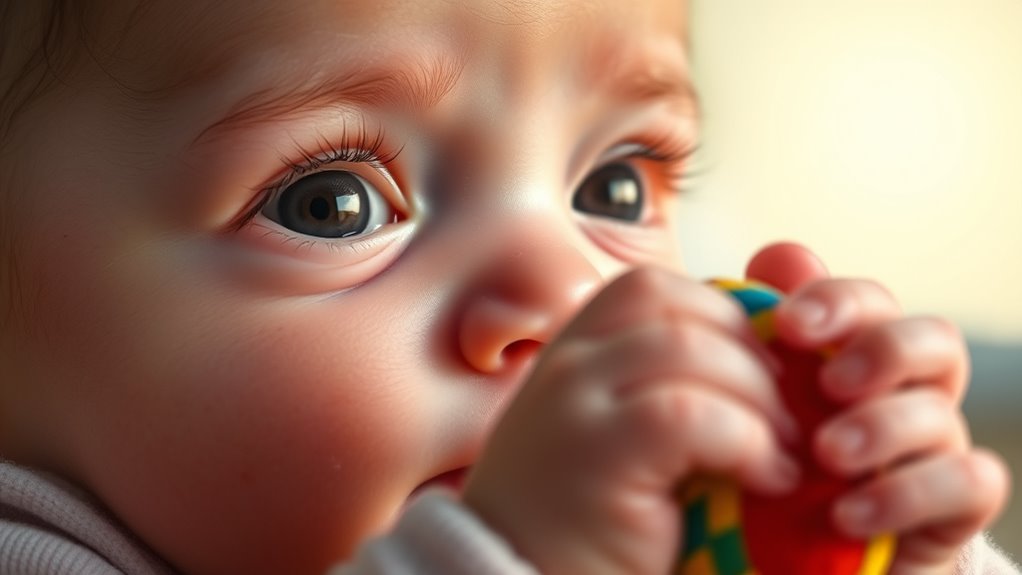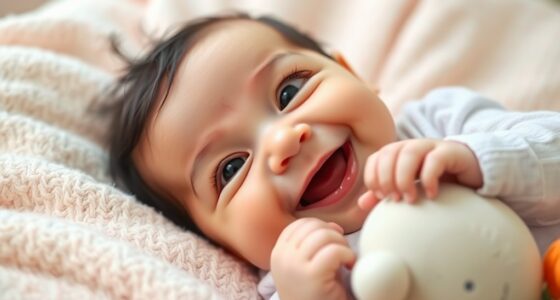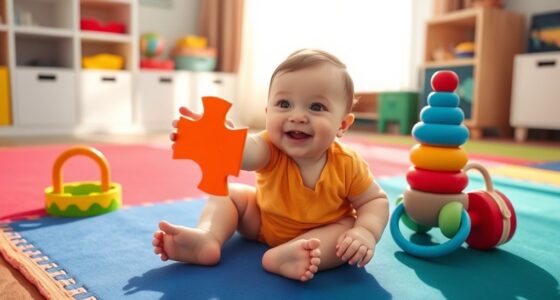In the first year, your baby’s vision rapidly develops from blurry black-and-white images to bright, sharp colors. Initially, they focus on nearby objects and recognize high-contrast patterns. By around two months, they begin recognizing familiar faces and responding to facial expressions. Their depth perception and eye coordination improve over time, allowing better tracking and exploration. As their vision matures, they gain important skills that support future learning—keep exploring to see what comes next!
Key Takeaways
- Newborns can focus on nearby objects and recognize high-contrast patterns, especially black and white.
- Around two months, babies begin recognizing familiar faces and responding to facial expressions.
- Visual clarity and eye coordination improve gradually, enabling better tracking of moving objects.
- Color vision develops around two to three months, with preference for bright, bold colors like red and black.
- By the end of the first year, babies can distinguish fine details, perceive depth, and track objects smoothly.
The First Few Days: Newborn Vision Abilities
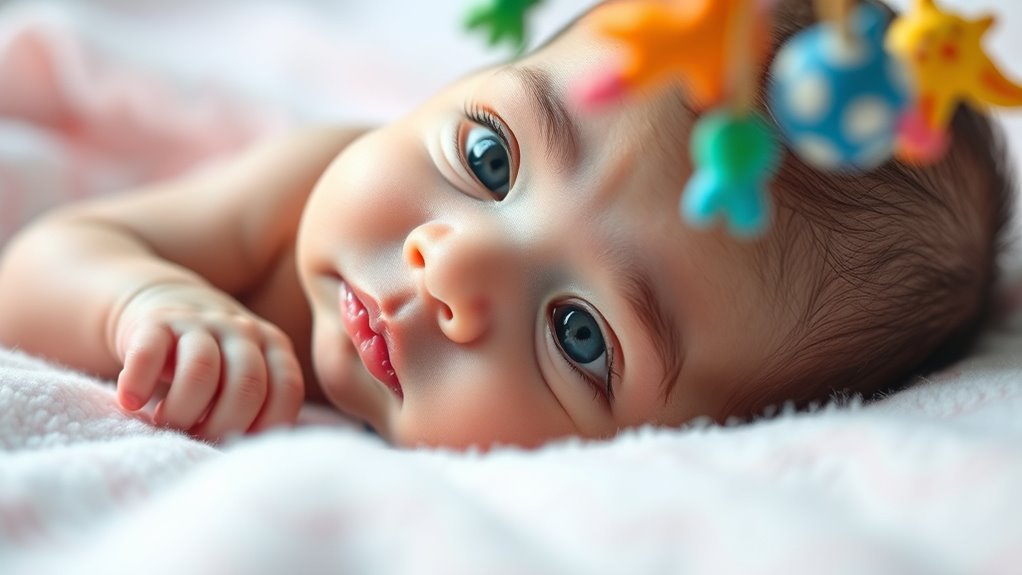
In the first few days after birth, your newborn’s vision is still developing but surprisingly functional. During this early stage, visual development is rapid, and infant eyesight is limited but enough to focus on nearby objects. Your baby can see shapes and contrasting colors, especially black and white, which help stimulate their visual senses. They are naturally drawn to high-contrast patterns and bold outlines, aiding their ability to focus. Although their eyesight is blurry compared to adults, your newborn can recognize familiar faces and respond to movements. Recognizing visual development as a critical process helps parents understand the importance of engaging their baby with simple, high-contrast images and gentle interactions. Early exposure to high-contrast visuals can support their visual acuity growth during this foundational stage. This initial phase is vital for setting the foundation of their visual skills. As days pass, their eyesight will improve, and they’ll start tracking objects and recognizing faces more clearly. Providing varied visual stimuli encourages healthy visual growth, which is essential for their overall development. Additionally, consistent visual stimulation can promote neural connections related to sight, supporting their long-term visual health. Incorporating a variety of visual experiences, such as different patterns and movements, can further enhance their developing vision skills and overall cognitive development.
Recognizing Faces and Human Features
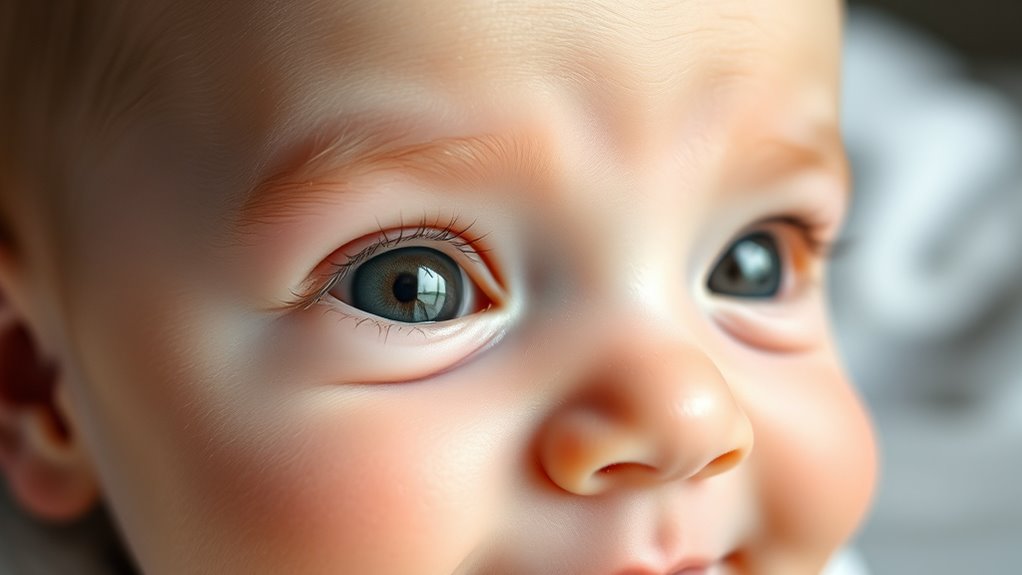
As your baby’s vision continues to sharpen, they become increasingly interested in faces and human features. You’ll notice they focus on facial expressions, which helps them start to understand emotions. Your baby begins to recognize familiar faces, especially those of you and close family members, by around two months. They respond to different facial features, like eyes and mouth, and can distinguish subtle changes in facial expressions. This early ability to interpret emotional cues lays the foundation for social bonding. Additionally, their developmental milestones include improved visual acuity and the ability to track moving objects, which supports their overall visual and social development during their first year. As their visual skills develop, they also begin to notice color differentiation, enhancing their ability to recognize and respond to their environment. Recognizing faces and human features is a crucial part of this process and can be further supported through visual stimulation tools and activities that promote healthy visual development during this critical period. Engaging your baby with contrasting patterns and familiar faces can accelerate their visual recognition skills and foster deeper emotional connections.
Depth Perception and Focus Development

Your baby’s ability to perceive depth and focus sharpens considerably during the first few months. As their visual system develops, binocular vision improves, allowing both eyes to work together effectively. This coordination is essential for depth perception, helping your baby judge distances accurately. In the early months, their visual focus becomes clearer, enabling them to see objects at various distances with more precision. You might notice your baby tracking moving objects or gradually focusing on closer items. This progress is crucial for exploring their environment and developing motor skills. Keep in mind that visual focus and binocular vision develop gradually, so patience and engaging, eye-friendly activities can support this exciting growth phase. Additionally, understanding the typical development of supermarket hours can help you plan outings that align with your baby’s visual and sensory development needs.
Color Vision Progression in Infants
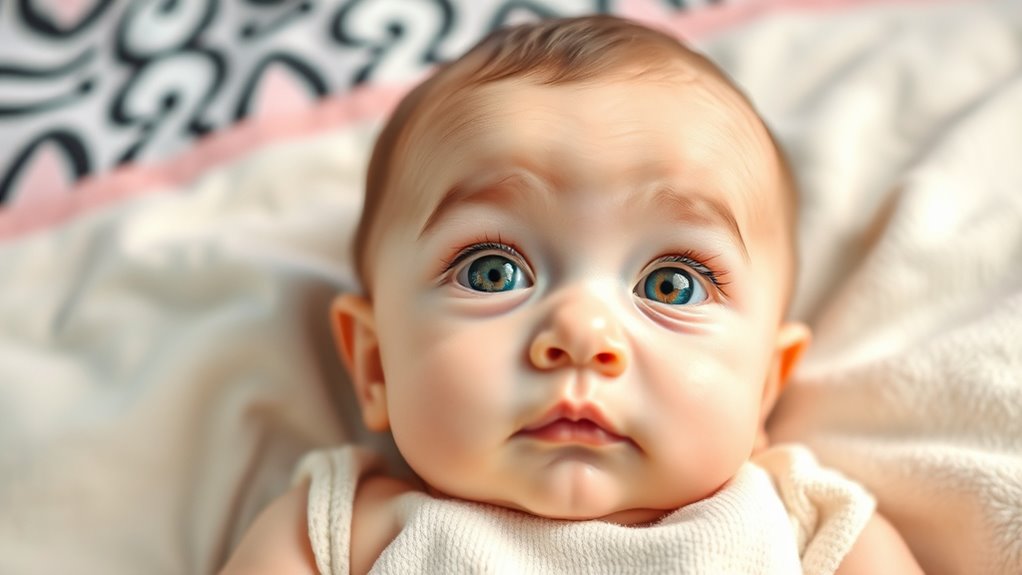
During the first few months, infants’ color vision rapidly develops, allowing them to distinguish between different hues. Early on, babies primarily see in shades of gray, but by about two months, their color discrimination improves considerably. You’ll notice they prefer high-contrast, bold colors like red and black because these catch their attention more easily. As their cones in the retina develop, their visual preference shifts toward more vibrant, varied colors. Around three months, they start to differentiate between colors more clearly, showing a growing ability to recognize and respond to familiar hues. This progression helps your baby explore their environment visually, making their world more engaging and stimulating as their color vision becomes more refined. Additionally, understanding the milestones in color vision progression can help parents support their baby’s visual development effectively. Recognizing the importance of visual milestones can guide caregivers in providing appropriate visual stimuli during this critical period. Studies show that early exposure to a variety of colors can further support visual development and enhance their perceptual skills.
Tracking Moving Objects and Eye Movement Skills
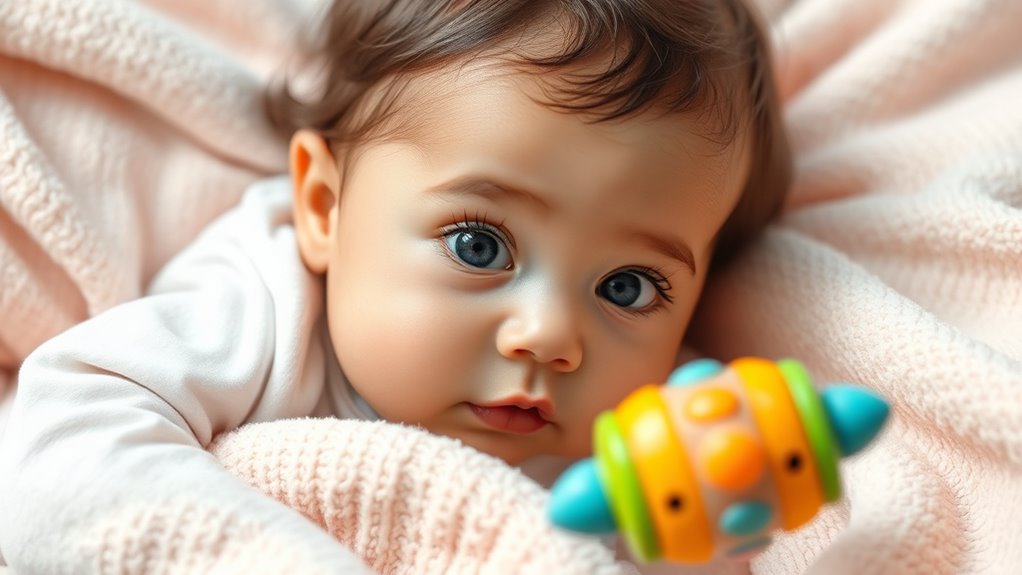
Have you noticed how your baby’s eyes seem to follow moving objects? That’s a sign of developing ocular coordination, which helps their eyes work together smoothly. In the first months, your baby begins to track objects side to side and up and down. This skill improves as their eye muscles strengthen. Peripheral awareness also plays a role; your baby starts to notice movement outside their direct line of sight, enhancing their ability to respond to their environment. These eye movement skills are essential for future visual tasks like reading and depth perception. Encouraging your baby to follow toys or faces can support this development. For example, preppy dog names are often inspired by fashion and culture, much like how the development of eye coordination reflects a baby’s growing awareness of their environment. Remember, these skills develop gradually, so patience is key as your baby learns to coordinate their eyes effectively.
Visual Acuity Improvements Over Months
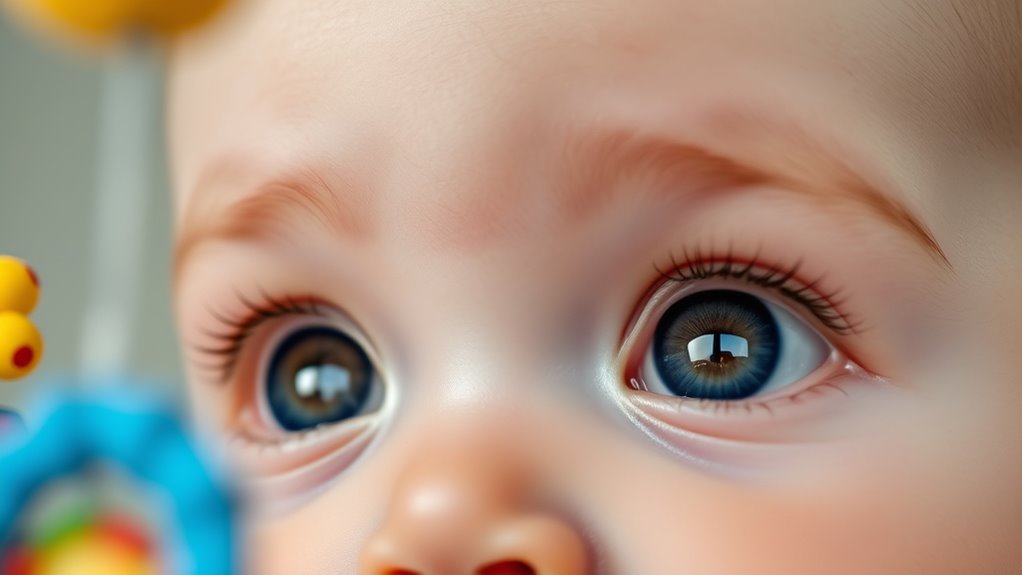
In the first few months, you’ll notice your baby’s vision improves rapidly as their eyes focus more clearly. Over time, their visual clarity becomes steadier, making it easier to see objects and faces. You’ll also observe key milestones as their focus sharpens and they begin to track moving items more accurately. Regular exposure to indoor air quality can support healthy development of their respiratory and overall health, potentially influencing their visual growth.
Rapid Early Improvements
How quickly does a baby’s vision improve in the first few months? In this period, your baby’s visual acuity sharpens rapidly. The visual cortex develops quickly, allowing clearer image processing. Eye coordination also improves, helping your baby focus on objects and track movement more accurately. During these months, your baby begins to see with greater detail, making objects appear less blurry. This rapid growth supports their ability to recognize faces and follow moving toys. The brain’s visual pathways become more efficient, transforming blurry images into clearer perceptions. These early improvements are essential for your baby’s overall development, laying the foundation for future visual skills. Additionally, neural development accelerates during this stage, further enhancing your baby’s ability to interpret visual stimuli. Moreover, the development of visual perception skills enables your baby to better understand their environment. By the end of this period, your baby’s vision has made significant strides, setting the stage for continued visual exploration.
Steady Visual Clarity
As months pass, your baby’s visual clarity continues to improve steadily. During this time, their visual acuity sharpens, allowing them to see more fine details and distinguish objects at greater distances. You might notice your baby focusing more clearly on faces, toys, and everyday objects. This steady clarity results from the ongoing development of their visual system, including better coordination between the eyes and brain. As their eyes mature, they can track moving objects more smoothly and see with increasing precision. You’ll see their vision become clearer and more defined, laying the foundation for future visual milestones. Additionally, advancements in neural development support sharper visual processing, further enhancing their ability to interpret visual information. Regular eye check-ups and vision assessments can help monitor this progress and ensure healthy visual development. Ensuring a safe environment free of hazards can also promote optimal eye health during this critical growth period. Moreover, understanding the role of visual acuity development can help parents support their baby’s sensory growth effectively.
Milestones in Focus
Your baby’s visual acuity improves considerably over the first few months, marking key milestones in their ability to see clearly. During this time, you’ll notice increased visual attention as they focus more intently on faces, objects, and colors. Their eye coordination also develops rapidly, allowing them to track moving objects smoothly and accurately. By around two months, your baby begins to recognize familiar faces and follow objects across their visual field. As months progress, their ability to distinguish fine details improves, making their vision sharper. These milestones reflect the strengthening connection between their eyes and brain, enabling clearer sight and better focus. Encouraging your baby’s visual attention and eye coordination through simple activities supports their ongoing visual development.
The Role of Visual Stimulation in Development
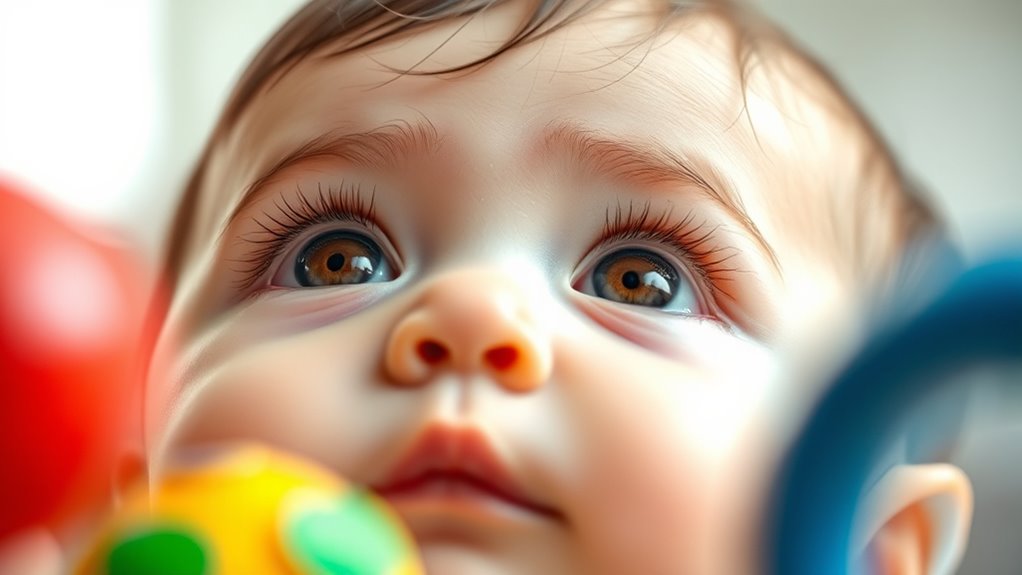
Visual stimulation plays a crucial role in shaping a baby’s developing brain and visual system. When you provide engaging sights, you help strengthen their visual motor coordination, which is essential for reaching and grasping objects. Bright colors, contrasting patterns, and moving visuals encourage your baby to track and focus, boosting their peripheral awareness. This heightened peripheral awareness allows them to notice objects and movement outside their direct line of sight, supporting spatial understanding and safety. Regular exposure to varied visual stimuli promotes neural connections that underpin future visual skills. Your active involvement in offering visual experiences helps your baby develop the foundation for deeper visual perception, coordination, and overall cognitive growth during this critical stage.
Milestones in Vision by the End of the First Year
By the end of your baby’s first year, you’ll notice they start recognizing colors and distinguishing between different shades. Their ability to judge distances improves as their depth perception develops, helping them explore their environment. Additionally, their visual tracking skills become more precise, allowing them to follow moving objects smoothly.
Color Recognition Emerges
Around the age of four to six months, babies start to recognize and distinguish between different colors, marking an important milestone in their visual development. During this period, your baby’s color perception becomes more refined, allowing them to notice subtle differences and vibrant hues. You’ll likely see your little one showing visual preferences for bright, bold colors like red, yellow, and blue. These preferences help stimulate their developing visual system and encourage exploration. As their color recognition improves, they’ll begin to respond more actively to colorful objects, tracking them with greater accuracy. This stage is essential for building the foundation for more complex visual skills. Keep offering colorful toys and objects to support their visual learning journey.
Depth Perception Develops
As your baby’s ability to distinguish colors improves, their depth perception begins to develop, allowing them to better judge distances and spatial relationships. This progress relies on the development of binocular vision, which lets both eyes work together to create a single, three-dimensional view. The visual cortex, located in the brain, processes this information, helping your baby understand how far objects are from them. By around six months, their brain starts integrating signals from both eyes more effectively, improving their ability to perceive depth accurately. This milestone is essential for reaching other skills like reaching for toys or crawling. As their visual system matures, your baby gains a clearer sense of their environment, making interactions more engaging and meaningful.
Visual Tracking Improves
During the first year, your baby’s ability to track moving objects improves considerably, marking a key milestone in their visual development. As their eye coordination strengthens, they begin to follow objects smoothly across their field of vision. You might notice your baby turning their head or moving their eyes to keep up with a toy or a face. This progress in visual tracking helps them understand their environment better and prepares them for more complex skills like reaching and grasping. Consistent exposure to colorful, moving objects encourages this development, so engaging your baby with toys or faces that move naturally helps sharpen their eye coordination. By the end of the year, your little one will be able to follow objects across their visual field with increased accuracy, demonstrating significant growth in their visual tracking skills.
Frequently Asked Questions
When Can Babies Differentiate Between Similar Colors?
You might wonder when your baby can differentiate between similar colors. Typically, around 3 to 4 months, they start developing better color recognition, allowing them to distinguish more subtle shades. As their depth perception improves, usually by 4 to 6 months, they gain a clearer understanding of spatial relationships. Keep providing colorful, contrasting toys to support their visual development and help refine both color recognition and depth perception.
How Does a Baby’s Vision Influence Their Overall Development?
Your baby’s vision plays a essential role in their overall development. As they develop, their ability to perform visual tracking helps them follow objects and people, boosting coordination. Depth perception improves, allowing them to judge distances accurately, which is critical for exploring their environment safely. These visual skills support their cognitive, motor, and social growth, helping them connect with others and learn about the world around them.
Are There Signs of Vision Problems in Infants?
If you’re concerned about signs of vision problems in your infant, watch for unusual eye movements, persistent eye rubbing, or if their eyes don’t seem to focus or follow objects. Regular vision screening helps guarantee their eye health and early detection of issues. Early intervention is vital, so consult your pediatrician if you notice anything unusual, as maintaining good eye health supports their overall development.
How Can Parents Support Their Baby’s Visual Development?
They say “a picture is worth a thousand words,” so you can help your baby’s visual growth by encouraging their visual tracking and eye coordination. Use high-contrast toys, move them slowly to stimulate tracking, and make eye contact often. Provide a safe, stimulating environment filled with colorful objects. Your gentle guidance and patience will help develop their visual skills, laying a strong foundation for future learning.
What Are Common Vision Milestones After the First Year?
After the first year, you’ll notice your child’s vision milestones like improved eye-hand coordination, depth perception, and better focus. To support ongoing development, consider vision therapy and simple eye exercises that strengthen their eye muscles and improve coordination. Regular eye check-ups are essential to catch any issues early. Engage in activities like puzzles and drawing to stimulate visual skills, helping your child develop healthy, sharp vision through active participation.
Conclusion
By the end of your baby’s first year, their vision has made incredible strides, from blurry newborn sights to clear, focused attention. Did you know that by six months, most babies can recognize familiar faces from across the room? Keep providing visual stimulation, and watch their skills blossom. Every milestone, big or small, shows how your little one is developing their unique way of seeing the world—one step closer to full visual clarity.

